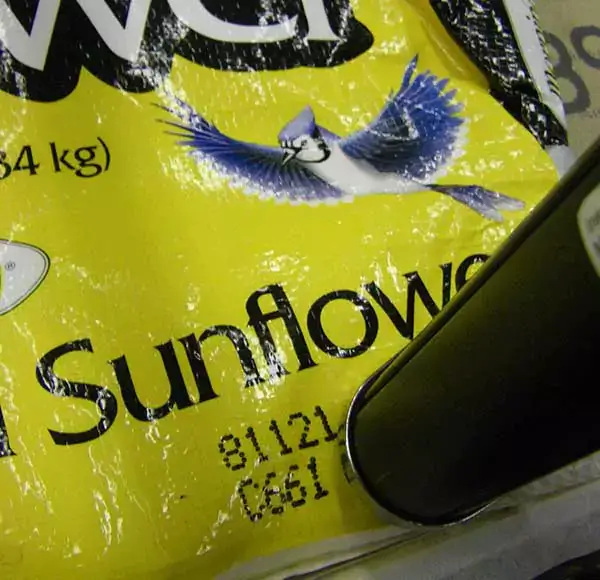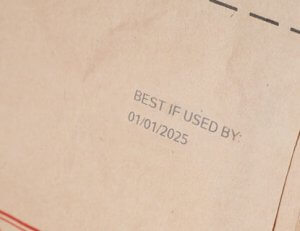Three questions you should ask when looking for a bag marking solution
Countless consumer and industrial products come delivered in bags, pouches and other types of flexible packaging in all shapes and sizes – from industrial supplies like 94 lb. bags of cement to grocery items like flour and pet food. In contrast to the rigidity and conformity of cardboard boxes, the variety of types of bags and pliability of each substrate mean that careful consideration must be paid to marking and coding processes to ensure clean, readable and scannable marks every time.
Placing loose, wet, granular or powdery products in bags inevitably creates dust and other pollution on the manufacturing floor. Temperature fluctuations, vibration and uneven shapes and sizes are more the rule than the exception. Because of this bag marking, printing and labeling solutions need to be versatile and able to withstand a variety of sub-optimal conditions, especially in factories that produce high volumes of consumer goods or industrial materials.
1. What makes bag marking challenging?
With the rise and importance of product traceability globally, it’s more important than ever that bagged products are marked accurately and consistently during the production process. But this isn’t as easy as it sounds. Bag marking comes with its own set of challenges, including:
Uneven or textured surfaces
Bags have different surface textures (e.g. smooth or rough), and can be porous or nonporous. Some of these surfaces can pose challenges for printing or labeling processes, as they may require the use of specialized inks capable of adhering to slick or shiny surfaces.
Timing of the fill
If printing takes place before the bag is filled, you’ll have more consistency and flat, even surface areas to work with. But more often than not, marks and codes are printed post fill. This can result in uneven shapes and print areas and often requires the use of custom guides and rails to obtain consistent results.
Harsh environments
The importance of managing harsh conditions can’t be overstated. The production floor can expose bag marking and labeling machines to a variety of difficult environmental conditions such as dust, heat, humidity, or chemicals. These factors directly affect both mark quality and equipment reliability if they aren’t managed correctly.
Bag materials
Different bag materials or substrates, such as plastic, paper, or woven materials, require different marking and coding techniques. The manufacturing environment determines the choice of materials based on factors like durability, product protection, and cost. The chosen material may affect the type of ink or labels or printing method used for marking and coding.

A Matthews V-Series DOD valvejet printer creates a large character mark on a filled bag of wild bird sunflower seeds. The printer’s long-throw distance accommodates the bag’s curved surface.
2. What are the most important considerations when purchasing bag marking equipment?
As alluded to above, bag marking and coding is far from a walk in the park. When purchasing or upgrading your bag marking machines or preparing to add bag marking to your production line, you’ll want to fully understand the following factors:
Print durability
Bags are often subjected to handling, transportation, and environmental conditions that can cause rubbing, abrasion or fading. Marks and codes applied to the bags must withstand whatever abuse they will face after the production. For this reason, you should always obtain sample marks on the bags you’re marking, and then test the marks for durability under conditions similar to what they will face post production.
Types of codes or marks
The type of product you’re bagging often dictates the marks and codes you need. Required codes may include: 1D or 2D barcodes, ”best by” dates, serial numbers, and/or lot, weight and batch codes. While some of these marks may be more for the consumer or for simple identification purposes, others (such as barcodes and serial numbers) must be very clearly readable and scannable as they play a key role in the supply chain, primarily for inventory, tracking, and traceability. As a rule of thumb, machine-readable codes need to be of higher resolution than human readable marks.
Throw distance
As noted above, most bags are marked post-fill resulting in uneven shapes and curved or oddly shaped surfaces. Marking on curved surfaces requires printers with longer print or throw distances (defined as the maximum allowable distance between the printer and the item being marked). While continuous inkjet (CIJ) and drop-on-demand (DOD) valvejet can both handle longer throw distance and maintain print quality, only DOD can produce the larger character marks needed for most industrial applications.
Printing speed
Marking and coding processes need to keep up with the speed of your production line. As speeds ramp up, some printing technologies may struggle and/or mark quality can suffer. While most marking technologies have little to no trouble matching line speeds, it is something to be aware of and worth discussing with your vendor if you have exceptionally high speeds on your line.
Ink selection
Choosing the right ink for your printer and bag substrate helps to maximize quality, reduce the cost per mark, and ensure reliable equipment performance. For more information about selecting the best ink for your products, we recommend reading our blog post series understanding ink to drive marking and coding success.
These considerations, along with the bag substrate and required character size, will help determine if a will create the best, longest-lasting mark on your products. For some applications, automated print and apply labeling may also be worth exploring.
Selecting the correct technology is critical to bag marking success.
For example, DOD valvejet printers are known for longevity in the harshest industrial environments, making them an ideal bag marking solution for manufacturers of products that produce high amounts of dust and other contaminants or chemical compounds that may end up on the bag’s surface.
CIJ printers, on the other hand, struggle to perform in dusty environments, and can unexpectedly fail as temperatures rise or fall, making them ill-suited for many bag marking applications. In other cases, you may need the high resolution of TIJ printers.

Thermal inkjet (TIJ) printers are the best choice for high-resolution marks like this.
3. What are the consequences of poor bag marking?
Poor bag marking can lead to a host of costly issues, both to your bottom line and your reputation. Three of the most common include:
Marking errors
Bottlenecks and unplanned downtime can wreak havoc on your production lines’ overall equipment efficiency and cost your company thousands or even hundreds of thousands of dollars a day. In addition, if marks are not clear or consistent or the wrong marks are on the wrong bags, re-marking bags can be a significant waste of time and resources.
Poor legibility
Barcodes that are unable to be scanned or are unreadable due to smudged or missing information may have difficulties being traced through the supply chain process, resulting in delays, confusion and lost inventory. In addition, you may face issues verifying the authenticity of your products and open a door for counterfeiters.
Compliance issues
Marks and codes that are missing or unreadable may violate compliance and/or safety regulations, which may mean legal repercussions, penalties, and/or expensive fines for your organization. In addition, poor batch marking can lead to costly issues in the unfortunate event of a product recall.
You bag it, we’ll mark it
Our V-Series DOD valvejet printers are the most reliable in the industry for bag marking, and rugged enough to withstand the harshest of manufacturing environments. With the V-Series, you’ll be able to mark in big, bold alphanumeric characters and can run for 9 billion cycles before they need tuning — the longest printhead life in the industry. For high-resolution applications, our L-Series TIJ printers are up to the task with up to 600 dpi resolution and support for lines speeds up to 1,600 ft./min.
In addition, our MPERIA® A-Series automatic print and apply labeler enables consistent, error-proof, and precise label placement with an advanced safety design that eliminates the need for bulky cages and bolt-on protection systems. And its compact frame fits in most, if not all, confined spaces on your production floor.
And that’s only the start…complete the form below to learn how we can help you overcome your toughest bag marking challenges. We’d love to give you a free demonstration and consultation! Learn more about marking systems on our bag marking page.
